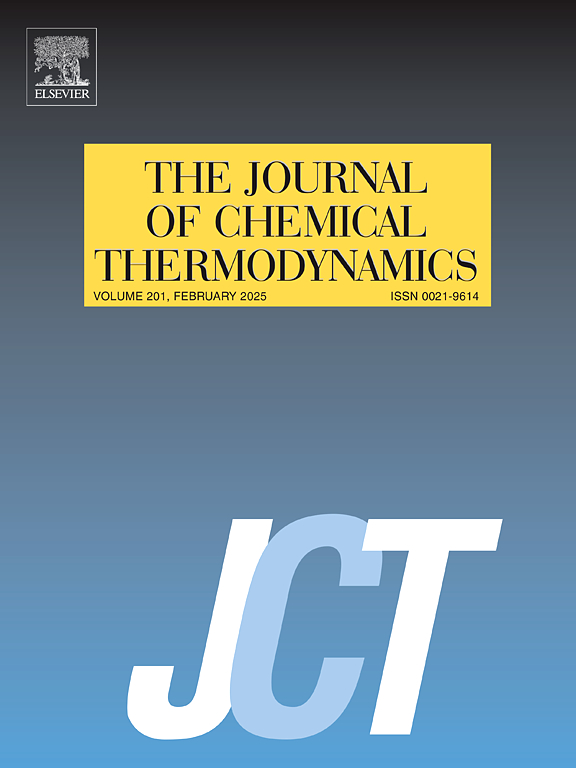Research on solubility, solvent effect and thermodynamics analysis of Lisinopril dissolution and molecular dynamics simulation
IF 2.2
3区 工程技术
Q3 CHEMISTRY, PHYSICAL
引用次数: 0
Abstract
The knowledge of solubility is indispensable in the pharmaceuticals development, crystal forms design, manufacturing and application. The high-quality solubility facilitates the selection of appropriate solvents for the formulation and purification of pharmaceutical products. In this study, the phase equilibrium of Lisinopril was established in ethanol, 1-propanol, 2-propanol, 1-butanol, acetone, acetonitrile, ethyl acetate, dimethyl sulfoxide (DMSO), N,N-dimethylformamide (DMF), N-methylpyrrolidone (NMP), as well as mixtures of DMSO + ethanol and DMSO +2-propanol. The solubility, solvent effect discussion, molecular dynamics (MD) simulations, molecular interaction analysis, model correlation and thermodynamics evaluation were all conducted. The outcomes of Lisinopril solubility in molarity show a direct correlation with temperature, and the rank was as listed: DMSO (1.013 × 10−3, 318.15 K) > ethanol (3.887 × 10−4, 318.15 K) > 1-propanol (3.277 × 10−4, 318.15 K) > NMP (2.292 × 10−4, 318.15 K) > 1-butanol (1.642 × 10−4, 318.15 K) > DMF (1.217 × 10−4, 318.15 K) > 2-propanol (8.504 × 10−5, 318.15 K) > acetone (5.212 × 10−5, 318.15 K) > acetonitrile (3.201 × 10−5, 318.15 K) > ethyl acetate (1.851 × 10−5, 318.15 K). The solubility of Lisinopril in DMSO +2-propanol increased with the increasing content of DMSO, however, co-solvency phenomenon exhibited at w = 0.80 in mixture of DMSO + ethanol, and the maximum solubility is 1.271 × 10−3 (3.21-fold increase). The molecular interaction was discussed by preferential solvation in depth. Solvent effect was evaluated by KAT-LSER model which concluded that solute-solvent interactions significantly affect solubility more than solvent-solvent interactions. The contributions of solute-solvent interactions and solvent-solvent interactions 71.01 % and 28.99 %. Furthermore, MD simulation at the molecular level showed that hydrogen bonds can form more readily between molecules and play a crucial role in enhancing dissolution of Lisinopril. Additionally, the Apelblat, Wilson, Jouyban-Acree and Apelblat-Jouyban-Acree models were applied to correlate the Lisinopril solubility data. The greatest values of relative average deviation (RAD) and root-mean-square deviation (RMSD) values were 1.75 % and 1.68 × 10−5, respectively. Finally, the values of thermodynamic properties were all positive which indicated that the dissolution of Lisinopril was an endothermic and entropy increment process.
赖诺普利溶解度、溶剂效应、溶解热力学分析及分子动力学模拟研究
溶解度知识在药物开发、晶型设计、制造和应用中是不可或缺的。高溶解度有利于为药品的配制和纯化选择合适的溶剂。本研究建立了莱诺普利在乙醇、1-丙醇、2-丙醇、1-丁醇、丙酮、乙腈、乙酸乙酯、二甲亚砜(DMSO)、N,N-二甲基甲酰胺(DMF)、N-甲基吡咯烷酮(NMP)以及DMSO +乙醇和DMSO +2-丙醇混合物中的相平衡。进行了溶解度、溶剂效应讨论、分子动力学(MD)模拟、分子相互作用分析、模型关联和热力学评价。赖诺普利在摩尔浓度下的溶解度结果与温度直接相关,其等级为:DMSO (1.013 × 10−3,318.15 K) >;乙醇(3.887 × 10−4,318.15 K) >;-丙醇(3.277 × 10−4,318.15 K) >;NMP (2.292 × 10−4,318.15 K) >;-丁醇(1.642 × 10−4,318.15 K) >;DMF (1.217 × 10−4,318.15 K) >;2-丙醇(8.504 × 10−5,318.15 K) >;丙酮(5.212 × 10−5,318.15 K) >;乙腈(3.201 × 10−5,318.15 K) >;赖诺普利在DMSO +2-丙醇中的溶解度随着DMSO含量的增加而增加,但在DMSO +乙醇混合物中,w = 0.80时出现共溶解现象,最大溶解度为1.271 × 10 - 3,增加了3.21倍。通过优先溶剂化对分子相互作用进行了深入讨论。采用KAT-LSER模型对溶质效应进行了评价,结果表明溶质-溶媒相互作用对溶解度的影响大于溶质-溶媒相互作用。溶质-溶剂相互作用和溶剂-溶剂相互作用的贡献分别为71.01%和28.99%。此外,分子水平上的MD模拟表明,分子间更容易形成氢键,对赖诺普利的溶解起着至关重要的作用。此外,应用Apelblat、Wilson、Jouyban-Acree和Apelblat-Jouyban-Acree模型来关联赖诺普利的溶解度数据。相对平均偏差(RAD)和均方根偏差(RMSD)的最大值分别为1.75%和1.68 × 10−5。热力学性质均为正,表明赖诺普利的溶出是一个吸热熵增过程。
本文章由计算机程序翻译,如有差异,请以英文原文为准。
求助全文
约1分钟内获得全文
求助全文
来源期刊

Journal of Chemical Thermodynamics
工程技术-热力学
CiteScore
5.60
自引率
15.40%
发文量
199
审稿时长
79 days
期刊介绍:
The Journal of Chemical Thermodynamics exists primarily for dissemination of significant new knowledge in experimental equilibrium thermodynamics and transport properties of chemical systems. The defining attributes of The Journal are the quality and relevance of the papers published.
The Journal publishes work relating to gases, liquids, solids, polymers, mixtures, solutions and interfaces. Studies on systems with variability, such as biological or bio-based materials, gas hydrates, among others, will also be considered provided these are well characterized and reproducible where possible. Experimental methods should be described in sufficient detail to allow critical assessment of the accuracy claimed.
Authors are encouraged to provide physical or chemical interpretations of the results. Articles can contain modelling sections providing representations of data or molecular insights into the properties or transformations studied. Theoretical papers on chemical thermodynamics using molecular theory or modelling are also considered.
The Journal welcomes review articles in the field of chemical thermodynamics but prospective authors should first consult one of the Editors concerning the suitability of the proposed review.
Contributions of a routine nature or reporting on uncharacterised materials are not accepted.
 求助内容:
求助内容: 应助结果提醒方式:
应助结果提醒方式:


